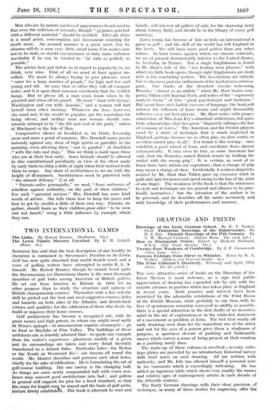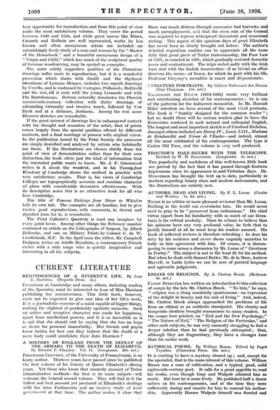DRAWINGS AND PRINTS
Drawings of the Early German School. By K. T. Parker, Ph.D. Florentine Drawings of the Quattrocento. By H. S. Ede. Flemish Drawings of the 17th Century. By T. W. Muchall-Viebrook. (Ernest Berm. 18s. each net.) Famous Etchings from Miter to Whistler. Notes by R. A. Walker. (Halton and Truseott-Smith. 5s.) The Print Collector's Quarterly. February and April, 1926. (Dent. 178. 6d. yearly.) THE very attractive series of books on the Drawings of the Great Masters is most welcome, as a sign that public appreciation of drawing has expanded side by side with the notable advance in practice which has taken place in England in recent years. Both practice and interest have been nourished by the admirable exhibitions of the Print Room of the British Museum, while probably to our time, with its love of spontaneous sensation conveyed as swiftly as possible, there is a special attraction in the first drafts of an inventive mind in the act of exploration, or in the white-hot statement of a movement or problem of form. The fact that nearly all early drawings were done for the immediate use of the artist and not for the eyes of a patron gives 'them a singleness of purpose, a spareness devoid of padding and fashionable sauces which convey a sense of being present at their creation as a painting rarely does.
The make-up of these volumes is excellent ; seventy collo- type plates are preceded by an introductory historical survey with brief notes on each drawing. All are written with authority, and Mr. Ede has allowed himself a personal note in his comments which is exceedingly refreshing. He has added an ingenious table which shows very readily the names and relative ages of contemporary artists in each decade of the fifteenth century.
The Early German drawings with their clear precision of technique, so many of them studies for engraving, offer -the best opportunity for reproduction, and from this point of view make the most satisfactory volume. They cover the period
between 1430 and 1550, and while great names like Darer, Cianach and llolbein are. well represented, works by less known and often anonymous artists are included—an , astonishingly lively study of a man and woman by the-`.`Master of the Housebook " and a beautiful anonymous design of a "...Virgin and Child," which has much of the sculptural quality of German woodcarving, may be quoted as examples.
I-The more subtly :suggestive qualities of the Florentine drawings suffer more in reproduction, but it is a wonderful procession which starts with Daddi - and the - rhythmic inventions of Lorenzo Monaco, includes two superb drawings by Uccello, and is continued by Castagno, Pollaiuolo, Botticelli and the rest, till it ends with the young Leonardo and with Fra Bartolommeo. Rubens naturally dominates the Flemish seventeenth-century collection with thirty drawings of astounding virtuosity and creative touch, followed by Van Dyck and at a distance, Jordaens. Among the rest some Brouwer sketches are remarkable.
:If the great interest of drawings lies in unhampered contact with the thought and sensation of the artist, that of prints comes largely from the special qualities offered by different methods, and a final marriage of process with original vision.
In the publication issued by the Print Society the processes are simply described and analysed by artists who habitually use them. If the illustrations are chosen chiefly from the point of view of demonstration rather than for their own distinction, the book offers just the kind of information that the interested public wants to know. Mr. J. F. Greenwood
writes in it about the woodcut, and in his Twenty-four Woodcuts of Cambridge shows the method in practice with
very satisfactory results. That is, his views of Cambridge Colleges are topographically accurate and combine character of place with considerable decorative effectiveness. With its descriptive notes this is an attractive book for all who love Cambridge.
The title of Famous Etchings from Borer to Whistler tells its own tale. The examples are all familiar, but to give twelve good reproductions, with comments, in decent and dignified form for 5s. is remarkable.
The Print Collector's Quarterly is read one imagines by every print lover. Among other things the February number contained an article on the Lithographs of Sargent, by Albert Bellerche, and one on Military Prints by Colonel C. de W. Crookshank, M.P. In the April issue the editor, Mr. Campbell Dodgson, writes on Adolfe Beaufrere, a contemporary French etcher with a wide range who is quietly imaginative and interesting in all his subjects.











































 Previous page
Previous page